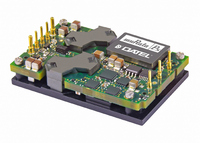UQQ-5/17-Q12PB-C Murata Power Solutions Inc, UQQ-5/17-Q12PB-C Datasheet - Page 17

UQQ-5/17-Q12PB-C
Manufacturer Part Number
UQQ-5/17-Q12PB-C
Description
CONV DC/DC 85W 17A 5V T/H
Manufacturer
Murata Power Solutions Inc
Series
UQQr
Type
Isolatedr
Datasheet
1.UQQ-128-Q12PB-C.pdf
(18 pages)
Specifications of UQQ-5/17-Q12PB-C
Output
5V
Number Of Outputs
1
Power (watts)
85W
Mounting Type
Through Hole
Voltage - Input
9 ~ 36V
Package / Case
8-DIP Module, 1/4 Brick
1st Output
5 VDC @ 17A
Size / Dimension
2.22" L x 1.45" W x 0.50" H (56.4mm x 36.8mm x 12.7mm)
Power (watts) - Rated
85W
Operating Temperature
-40°C ~ 85°C
Efficiency
90.5%
Approvals
CSA, cUL, EN, UL
Dc / Dc Converter O/p Type
Fixed
No. Of Outputs
1
Input Voltage
9V To 36V
Power Rating
85W
Output Voltage
5V
Output Current
17A
Approval Bodies
EN, IEC, UL
Supply Voltage
12V
Lead Free Status / RoHS Status
Lead free / RoHS Compliant
3rd Output
-
2nd Output
-
4th Output
-
Lead Free Status / RoHS Status
Lead free / RoHS Compliant, Lead free / RoHS Compliant
Other names
811-1892-5
Calculating Maximum Power Dissipation
To determine the maximum amount of internal power dissipation, fi nd the
ambient temperature inside the enclosure and the airfl ow (in Linear Feet per
Minute – LFM) at the converter. Determine the expected heat dissipation using
the Effi ciency curves and the converter Input Voltage. You should also compen-
sate for lower atmospheric pressure if your application altitude is considerably
above sea level.
The general proceedure is to compute the expected temperature rise of the
heatsink. If the heatsink exceeds +100°C. either increase the airfl ow and/or
reduce the power output. Start with this equation:
where “Ta” is the enclosure ambient air temperature and,
where “Ts” is the heatsink temperature and,
where “R4 [at airfl ow]” is a specifi c heat transfer thermal resistance (in
degrees Celsius per Watt) for a particular heat sink at a set airfl ow rate. We
have already estimated R4 [at airfl ow] in the equations above.
Note particularly that Ta is the air temperature inside the enclosure at the
heatsink, not the outside air temperature. Most enclosures have higher
internal temperatures, especially if the converter is “downwind” from other
heat-producing circuits. Note also that this “Pd” term is only the internal heat
dissipated inside the converter and not the total power output of the converter.
We can rearrange this equation to give an estimated temperature rise of the
heatsink as follows:
Heat Sink Example
Assume an effi ciency of 92% and power output of 100 Watts. Using equation
[4], Pd is about 8.7 Watts at an input voltage of 48 Volts. Using +30°C ambient
temperature inside the enclosure, we wish to limit the heat sink temperature to
+90°C maximum baseplate temperature to stay well away from thermal shut-
down. The +90°C. fi gure also allows some margin in case the ambient climbs
above +30°C or the input voltage varies, giving us less than 92% effi ciency.
The heat sink and airfl ow combination must have the following characteristics:
Since the ambient thermal resistance of the heatsink and pad is 12.5°C/W, we
need additional forced cooling to get us down to 6.9°C/W. Using a hypothetical
airfl ow constant of 0.005, we can rearrange equation [5] as follows:
Heatsink Kit *
Model Number
HS-QB25-UVQ
HS-QB50-UVQ
HS-QB100-UVQ
* Kit includes heatsink, thermal pad and mounting hardware. These are
non-RoHS models. For RoHS-6 versions, add “-C” to the model number
(e.g., HS-QB25-UVQ-C).
(Required Airfl ow, LFM) x (Airfl ow Constant) = R4[Nat.Convection] /
R4[at airfl ow] –1, or,
(Required Airfl ow, LFM) x (Airfl ow Constant) = 12.5/6.9 –1 = 0.81
Internal Heat Dissipation [Pd in Watts] = (Ts – Ta)/R4 [at airfl ow] [6]
Ts = (Pd x R4 [at airfl ow]) + Ta [7]
8.7 W = (90-30) / R4[airfl ow] or,
R4[airfl ow] = 60/8.7 = 6.9°C/W
These model numbers are correct for the UQQ series.
Still Air (Natural convection)
thermal resistance
10.6°C/Watt
12°C/Watt
8°C/Watt
Heatsink height
0.25" (6.35mm)
0.50" (12.7mm)
1.00" (25.4mm)
(see drawing)
www.murata-ps.com
On/Off Enable Control Ground Bounce Protection
To improve reliability, if you use a small signal transistor or other external
circuit to select the Remote On/Off control, make sure to return the LO side
directly to the –Vin power input on the DC/DC converter. To avoid ground
bounce errors, do not connect the On/Off return to a distant ground plane or
current-carrying bus. If necessary, run a separate small return wire directly to
the –Vin terminal. There is very little current (typically 1-5 mA) on the On/Off
control however, large current changes on a return ground plane or ground bus
can accidentally trigger the converter on or off. If possible, mount the On/Off
transistor or other control circuit adjacent to the converter.
and, rearranging again,
162 LFM is the minumum airfl ow to keep the heatsink below +90°C. Increase
the airfl ow to several hundred LFM to reduce the heatsink temperature further
and improve life and reliability.
Do not connect
control transistor
through remote
power bus
(Required Airfl ow, LFM) = 0.81/0.005 = 162 LFM
(2.54)
Wide Input Range Single Output DC/DC Converters
0.10
On/Off
Control
Transistor
* UQQ SERIES HEATSINKS ARE AVAILABLE IN 3 HEIGHTS:
Figure 9. On/Off Enable Control Ground Bounce Protection
0.140 DIA. (3.56) (4 PLACES)
MATERIAL: BLACK ANODIZED ALUMINUM
0.25 (6.35), 0.50 (12.70) AND 1.00 (25.4)
Ground plane or power return bus
Dimensions in inches (mm)
Figure 8. Optional Heatsink
(57.91)
(47.24)
1.860
2.28
Preferred location
of On/Off control
adjacent to -Vin
terminal
25 Mar 2011 MDC_UQQ.B01 Page 17 of 18
email: sales@murata-ps.com
UQQ Series
Install separate
return wire for
On/Off control
with remote
transistor
(26.16)
1.03
*
DC/DC Converter
(36.83)
1.45
+ Vin
On/Off Enable
-Vin return



















